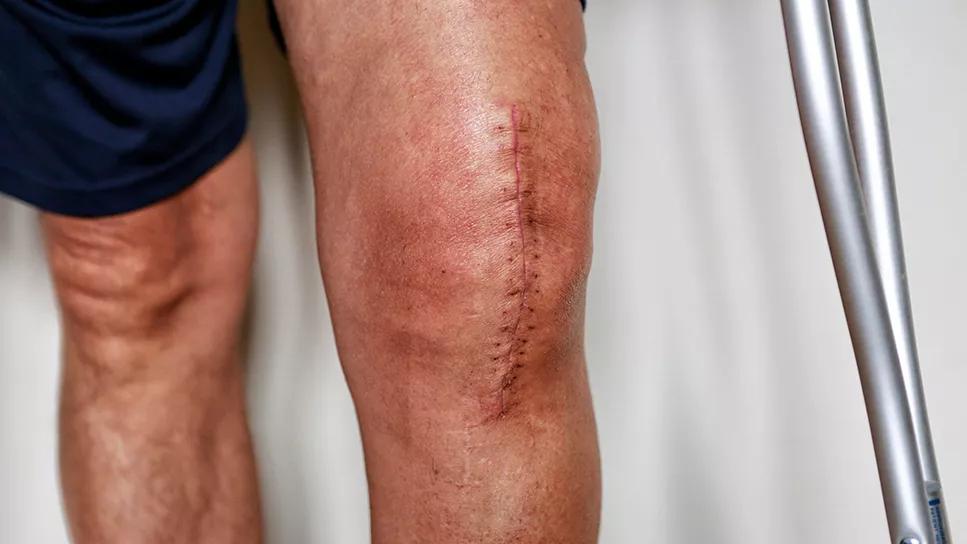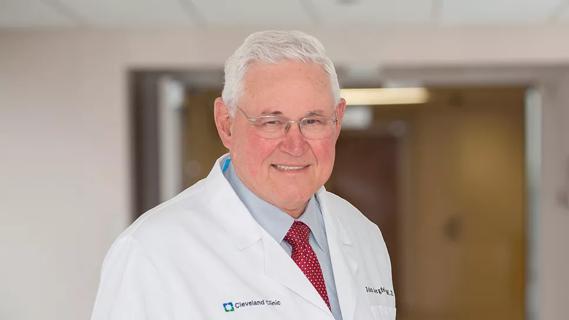How to diagnose and treat crystalline arthropathy after knee replacement

A patient presenting with joint inflammation, swelling and pain after total knee arthroplasty (TKA) can raise concern for periprosthetic joint infection. But don’t jump to conclusions, says Matthew Deren, MD, an orthopaedic surgeon at Cleveland Clinic. At times, these patients have crystalline arthropathy — such as gout or pseudogout (calcium pyrophosphate deposition [CPPD]) — conditions that can mimic infection.
Advertisement
Cleveland Clinic is a non-profit academic medical center. Advertising on our site helps support our mission. We do not endorse non-Cleveland Clinic products or services. Policy
One 2020 study reported that, based on Medicare data from 2009 to 2013, nearly 6% of patients age 65 or older having primary TKA also had gout. The combination is not uncommon.
“We see patients in clinic who complain of knee pain after TKA and have elevated labs, so we aspirate their synovial fluid to see if they have an infection,” says Dr. Deren. “However, sometimes the fluid we collect is inconclusive, not purulent but still questionable. And maybe the fluid is negative for bacterial infection. It’s hard to know how to best treat patients like this.”
Dr. Deren and a Cleveland Clinic team recently analyzed existing literature on the topic. They summarized their findings in a recent article in JBJS Reviews, providing an overview of diagnostic and treatment strategies for patients with joint inflammation, swelling and pain with or without fever after TKA.
The article includes a flow chart that outlines management steps after receiving the results of a lab test (including complete blood count, erythrocyte sedimentation rate and C-reactive protein) and arthrocentesis (including culture and analysis for crystals).
If blood test results are elevated and the synovial fluid is positive for bacteria, proceed with treatment for periprosthetic joint infection. However, if blood test results are elevated but the synovial fluid is negative for bacteria, proceed with treatment for gout if monosodium urate crystals are detected in the synovial fluid, or CPPD if calcium pyrophosphate crystals are detected.
Advertisement
The authors note that while ultrasound sometimes is recommended for diagnosing crystalline arthropathy, it is not needed in patients who have had TKA and, therefore, require joint aspiration to rule out infection.
Per recommendations summarized by the study authors, NSAIDs are the first line of treatment for crystalline arthropathy after TKA, followed by steroids (or colchicine for gout) if symptoms do not improve. This course of treatment is the same even in patients who have not had TKA.
If symptoms continue, reconsider treatment for joint infection, which can include debridement, antibiotics and revision arthroplasty. Concomitant crystalline arthropathy and periprosthetic joint infection is possible.
“As orthopaedic surgeons, we’ve been conditioned to quickly diagnose and treat periprosthetic joint infections,” says Dr. Deren. “Delaying treatment for an infection may sound dangerous to us, but it’s also dangerous to rush to do surgery in a patient who doesn’t need it.”
For patients with symptoms of acute joint infection who have crystals in their synovial fluid but a negative culture, it may be wise to wait one to two days to see if they improve with conservative treatment for crystalline arthropathy, he says.
“This is one reason not to hurry a patient into the OR,” he says. “Hopefully our study can help more physicians make a timely and accurate diagnosis of these postoperative complications.”
Advertisement
Advertisement

Self-care may be just as effective for some patients

Most return to the same sport at the same level of intensity

Largest cohorts to date reveal low rates of major complications

More report a clinically meaningful change in function at 90 days compared to patients with lower BMI

Patient climbs Mount Kilimanjaro 8 months after surgery

Sports medicine pioneer John Bergfeld, MD, shares how orthopaedics has changed since doing his first ACL repair in 1970

Special glasses allowed surgeon to see 3D models and anatomic data superimposed on surgical field

When procedure is performed by high-volume surgeons, outcomes are comparable to total knee replacement